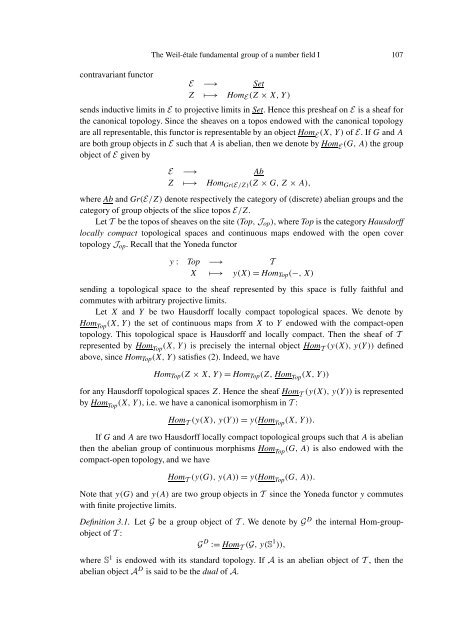THE WEIL-´ETALE FUNDAMENTAL GROUP OF A NUMBER FIELD I
THE WEIL-´ETALE FUNDAMENTAL GROUP OF A NUMBER FIELD I
THE WEIL-´ETALE FUNDAMENTAL GROUP OF A NUMBER FIELD I
You also want an ePaper? Increase the reach of your titles
YUMPU automatically turns print PDFs into web optimized ePapers that Google loves.
The Weil-étale fundamental group of a number field I 107<br />
contravariant functor<br />
E −→ Set<br />
Z ↦−→ Hom E (Z × X, Y )<br />
sends inductive limits in E to projective limits in Set. Hence this presheaf on E is a sheaf for<br />
the canonical topology. Since the sheaves on a topos endowed with the canonical topology<br />
are all representable, this functor is representable by an object Hom E (X, Y ) of E.IfG and A<br />
are both group objects in E such that A is abelian, then we denote by Hom E (G, A) the group<br />
object of E given by<br />
E −→ Ab<br />
Z ↦−→ Hom Gr(E/Z) (Z × G, Z × A),<br />
where Ab and Gr(E/Z) denote respectively the category of (discrete) abelian groups and the<br />
category of group objects of the slice topos E/Z.<br />
Let T be the topos of sheaves on the site (Top, J op ),whereTop is the category Hausdorff<br />
locally compact topological spaces and continuous maps endowed with the open cover<br />
topology J op . Recall that the Yoneda functor<br />
y : Top −→ T<br />
X ↦−→ y(X) = Hom Top (−,X)<br />
sending a topological space to the sheaf represented by this space is fully faithful and<br />
commutes with arbitrary projective limits.<br />
Let X and Y be two Hausdorff locally compact topological spaces. We denote by<br />
Hom Top (X, Y ) the set of continuous maps from X to Y endowed with the compact-open<br />
topology. This topological space is Hausdorff and locally compact. Then the sheaf of T<br />
represented by Hom Top (X, Y ) is precisely the internal object Hom T (y(X), y(Y )) defined<br />
above, since Hom Top (X, Y ) satisfies (2). Indeed, we have<br />
Hom Top (Z × X, Y ) = Hom Top (Z, Hom Top (X, Y ))<br />
for any Hausdorff topological spaces Z. Hence the sheaf Hom T (y(X), y(Y )) is represented<br />
by Hom Top (X, Y ), i.e. we have a canonical isomorphism in T :<br />
Hom T (y(X), y(Y )) = y(Hom Top (X, Y )).<br />
If G and A are two Hausdorff locally compact topological groups such that A is abelian<br />
then the abelian group of continuous morphisms Hom Top (G, A) is also endowed with the<br />
compact-open topology, and we have<br />
Hom T (y(G), y(A)) = y(Hom Top (G, A)).<br />
Note that y(G) and y(A) are two group objects in T since the Yoneda functor y commutes<br />
with finite projective limits.<br />
Definition 3.1. Let G be a group object of T . We denote by G D the internal Hom-groupobject<br />
of T :<br />
G D := Hom T (G,y(S 1 )),<br />
where S 1 is endowed with its standard topology. If A is an abelian object of T , then the<br />
abelian object A D is said to be the dual of A.

















